
Dig Dug is a maze arcade video game developed by Namco in 1981 and released in 1982, distributed in North America by Atari, Inc. The player controls Dig Dug to defeat all enemies per stage, by either inflating them to bursting or crushing them underneath rocks.

Mappy is an arcade game by Namco, originally released in 1983 and distributed in the United States by Bally Midway. Running on the Namco Super Pac-Man hardware modified to support horizontal scrolling, the game features a mouse protagonist and cat antagonists, similar to Hanna-Barbera's Tom and Jerry cartoon series. The name "Mappy" is likely derived from mappo (マッポ), a slightly pejorative Japanese slang term for policeman. The game has been re-released in several Namco arcade compilations. It spawned a handful of sequels and a 2013 animated web series developed by cartoonists Scott Kurtz and Kris Straub.

The Tower of Druaga is a 1984 arcade action role-playing maze game developed and published in Japan by Namco. Controlling the golden-armored knight Gilgamesh, the player is tasked with scaling 60 floors of the titular tower in an effort to rescue the maiden Ki from Druaga, a demon with eight arms and four legs, who plans to use an artifact known as the Blue Crystal Rod to enslave all of mankind. It ran on the Namco Super Pac-Man arcade hardware, modified with a horizontal-scrolling video system used in Mappy.

Marvel Land is a platform game released by Namco in arcades in 1990. It runs on the Namco System 2 hardware. The game was published for the Mega Drive in 1991, with the European version renamed Talmit's Adventure. The game shares its name with the fictitious kingdom where the 1986 Japan-only Famicom game Valkyrie no Bōken: Toki no Kagi Densetsu takes place, but has no connections with it otherwise. Likewise the game has no connections with Marvel Comics or any of their associated characters either. In December 2022, the arcade version of Marvel Land was re-released exclusively in Japan on the Nintendo Switch and the PlayStation 4 on the Arcade Archives lineup of digital arcade titles. It was originally planned for worldwide release at one point but was ultimately cancelled due to licensing issues with Disney and Hamster Corporation.
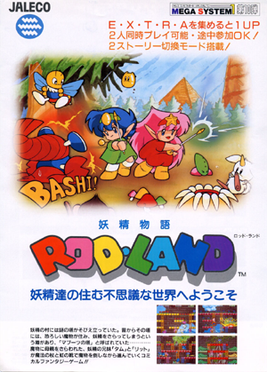
Rod Land, known in Japan as Yōsei Monogatari Rod Land, is a 1990 platform game originally developed and published in arcades by Jaleco.
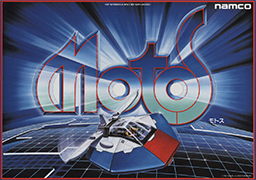
Motos is an arcade game that was released by Namco on September 20, 1985. It runs on Namco Super Pac-Man hardware but with a video system like that used in Mappy, The Tower of Druaga, Grobda and Dig Dug II.

Yokai Dochuki is a 1987 platform arcade game developed and released by Namco in Japan and other parts of Asia. The player controls a young boy named Tarosuke as he must make his way through Jigoku, the Japanese concept of Hell, to reach Buddha, who will determine his fate. Tarosuke can fire small "ki" bullets at enemies to defeat them; he can also charge them to increase their power. Enemies will drop money when defeated, which can be used to purchase weapons and other items in stores. Two versions of the arcade original were released: a Japanese version and an English version which was released in other Asian countries outside Japan. The Arcade Archives release includes both versions.
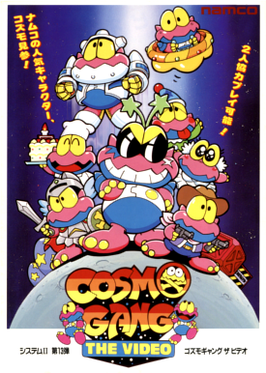
Cosmo Gang the Video is a 1992 fixed shooter arcade game developed and published by Namco. A home conversion for the Super Famicom was released the same year. Controlling the Hyper Beat starship, the player is tasked with ridding the galaxy of the Cosmo Gang, a race of aliens that cause mischief across Earth. Gameplay involves shooting enemies and avoiding projectiles. Power-up items can be collected to grant the player additional abilities. It ran on the Namco System 2 arcade board.

The Return of Ishtar is an action role-playing arcade video game released by Namco in 1986. It runs on Namco System 86 hardware and is the sequel to The Tower of Druaga, which was released two years earlier. The game's story directly starts after the first game, where Ki and Gil must venture down in the Tower of Druaga and escape it. It is the second game in the company's Babylonian Castle Saga series, and was later ported to the MSX, NEC PC-8801, FM-7, and Sharp X68000 platforms. The Return of Ishtar was included in the compilation game Namco Museum Volume 4 for the PlayStation, which is also the first time the game had been released overseas.

Pac-In-Time is a platform game developed by Kalisto and published by Namco, featuring the arcade character Pac-Man. It was released in 1995 for MS-DOS, Macintosh, Super Nintendo Entertainment System, and Game Boy.

The Nightmare of Druaga: Fushigi no Dungeon is a roguelike video game developed by Arika, Matrix Software, and Chunsoft, published in 2004 in Japan by Arika and in North America by Namco Hometek exclusively for the PlayStation 2. It is a sequel to The Tower of Druaga and the eighth game in Chunsoft's Mystery Dungeon series.
The Tower of Druaga: The Aegis of Uruk and its sequel, The Tower of Druaga: The Sword of Uruk, is a Japanese anime television series, created by Gonzo, and is an animated reboot/continuation of Namco's Babylonian Castle Saga video game franchise which began as an arcade game, The Tower of Druaga, originally released in 1984. This series is amongst the first to be officially broadcast on the internet by Gonzo simultaneously in Japanese and subtitled in English on YouTube, and BOST TV.
Game Studio Corporation Ltd. (株式会社ゲームスタジオ) is a video game production company headquartered in Shinagawa, Tokyo, Japan. It was founded on August 14, 1985, by former Namco employee Masanobu Endō, who continued to develop projects for Namco through his company. The company later made a subsidiary company called Mobile & Game Studio, while the goodwill was transferred.
Masanobu Endō is a Japanese game designer, president of Game Studio and Mobile & Game Studio, and the director of Digital Games Research Association Japan. He formerly worked for Namco, where he created arcade games and is best known for Xevious and The Tower of Druaga, which were important titles in the scrolling shooter and action role-playing game genres, respectively.
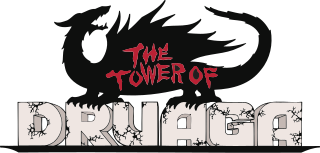
The Babylonian Castle Saga is a Japanese role-playing video game franchise developed and published by Bandai Namco Entertainment, formerly Namco, for arcades and home video game platforms. Beginning in 1984 with the arcade title The Tower of Druaga, the series would spawn a total of nine sequel and spin-off games, alongside a manga, soundtrack albums, and two anime series by Gonzo K.K. Later entries in the series would be developed by Endo's personal game company, Game Studio.
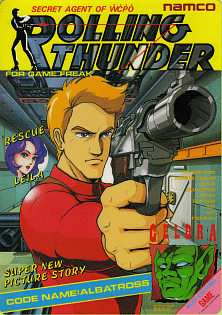
Rolling Thunder is a run and gun video game developed by Namco in Japan and Europe and released in 1986 as a coin-operated arcade video game using the Namco System 86 hardware. It was distributed in North America by Atari Games. The player takes control of a secret agent who must rescue his female partner from a terrorist organization. Rolling Thunder was a commercial success in arcades, and it was released for various home computer platforms in 1987 and the Nintendo Entertainment System in 1989. The original arcade game has been included in various classic game compilations as well. It influenced later arcade action franchises such as Shinobi and Time Crisis, which borrowed mechanics such as taking cover behind crates.
Let's! TV Play Classic is a series of Japan-only plug & play devices developed and distributed by Bandai programmed on XaviX software created by SSD Company Limited in 2006 that contain arcade games from either Namco or Taito, with Namco's being called "Namco Nostalgia" while Taito's are called "Taito Nostalgia". Each device in the series contains 4 games, with 2 being classic arcade games while the other 2 are new games using the original game's sprites developed by Bandai.

Namcot Collection, also known as Namco Museum Archives, is a 2020 video game compilation published by Bandai Namco Entertainment. Originally released in Japan for the Nintendo Switch, it was localized for international territories as two separate collections, Namco Museum Archives Vol. 1 and Vol. 2, for the Switch, Xbox One, PlayStation 4, and Windows. Namcot Collection includes a wide array of video games published by Namco for the Family Computer and Nintendo Entertainment System, with save states, achievements, and homebrew ports of Pac-Man Championship Edition and Gaplus.

Pac-Man 99 was a maze video game with battle royale elements developed by Arika and published by Bandai Namco Entertainment for the Nintendo Switch. It was released through the Nintendo Switch Online service on April 7, 2021.















